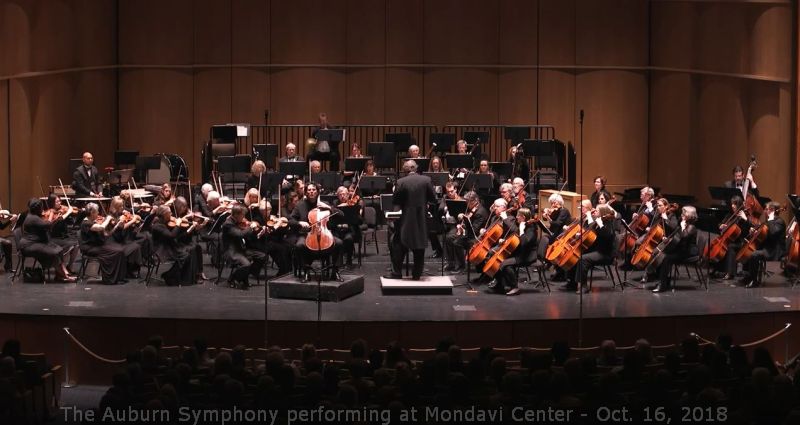Concert Review
The Auburn Symphony
From the Heart - January 18 & 19, 2020
(Note that the following is not a critical review. Instead, it is a description of what it was like to attend this concert from the perspective of the average, moderately well-informed audience member.)
The town of Auburn has a population of just 14,000 but it is the hub of a large foothill community that has a vibrant cultural life. And at the heart of that cultural life is the Auburn Symphony. Founded 30 years ago, it presents a season with 3 major concerts, drawing internationally respected guest artists, and it maintains a variety of community involvement activities. “From the Heart” was the second concert in their season. I attended on a Saturday night in the auditorium of Placer High School ― a repeat of the concert was held the following afternoon.
The concert began in an unusual way. The audience as greeted by Michelle Martin, a member of the First Violin section. She first explained that these greetings would be rotated in the future among orchestra members. Then Martin told a bit about her musical background and spoke glowingly of her welcome into the “family” of the Auburn Symphony. She also spoke briefly about the Auburn Symphony’s school outreach program. After she took her seat, the mandatory pre-concert announcements (cell phones, exits, etc.) were given by a lively disembodied male voice. He concluded with, “Now prepare to be amazed!” “Amazed” may be a bit of an exaggeration, but I can say that I was thoroughly delighted by what I heard during the ensuing 2 hours.
After Concertmaster Richard Altenbach led the tuning of the orchestra, Conductor Peter Jaffe entered from backstage to the welcoming applause of the audience. After a sweeping gesture to have the orchestra stand and be acknowledged ― and a brief silent communication with them ― he began the performance of Fanny Mendelssohn Hensel’s “Overture in C major.”
(Click here to open the concert program in a new window.)
I had arrived at the theater early enough to read all he concert notes, and I recommend this to anyone who is not already thoroughly familiar with the music to be played. For example, I was surprised to learn that Fanny Mendelssohn Hensel (Felix’s sister) was a prolific composer, though I don’t recall having heard any of her works performed. This and other details of Hensel’s life made an interesting prelude to hearing her “Overture in C major.” I have read many of Jane Vial Jaffe’s program notes (see the attached program), and besides being interesting from a historical perspective, I have appreciated her analysis of the music, helping me know what to listen for as it is being played.
Let me insert a very personal note here. My seat was in the first row, which put me no more than a dozen feet from the cello section and just a little more from Conductor Jaffe. They sell these seats at a discount, and I can hardly imagine why. Being so close gives you an intimate connection with the orchestra, and when they began to play this first piece, I felt absolutely caressed by the music ― with more intense sensations to follow.
After that initial caressing in the opening measures, there was a great sense of motion initiated by the violins. I watched them sway side to side as they played. It was as if they were moved by the rolling of waves of water. Presently the full orchestra built to an explosion of sound from which they receded a bit, but the music continued to be energizing. I had to smile at how wonderful it all was. And I think my delight was shared by a little girl I spotted in my row as she sat in rapt attention on her mother’s lap.
Naturally my attention turned frequently to Jaffe. I noticed that he
turned pages in the music on his music stand, but he rarely seemed to
look at them. Instead, he was making eye contact with one after another
of the sections of the orchestra, reminding them of the importance of
their part in a given passage, coaxing a bit more from them as the music
required. More than this, Jaffe conducts with passion.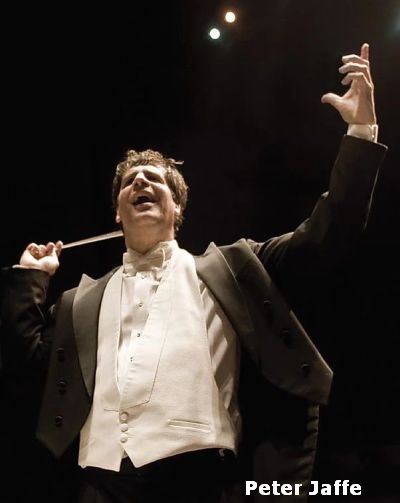 Far from just keeping time for the players, he evokes and reinforces
each dramatic moment with grand gestures from head to foot. Expressing
what he feels in the music is primarily for the benefit of the
orchestra, eliciting perhaps a bit more musicality from each player. But
his performance is also a benefit to the audience, giving us a more
profound understanding of the emotional significance of each musical
idea. Not surprisingly, when Jaffe turned to speak to us at the
conclusion of the piece, he was slightly out of breath.
Far from just keeping time for the players, he evokes and reinforces
each dramatic moment with grand gestures from head to foot. Expressing
what he feels in the music is primarily for the benefit of the
orchestra, eliciting perhaps a bit more musicality from each player. But
his performance is also a benefit to the audience, giving us a more
profound understanding of the emotional significance of each musical
idea. Not surprisingly, when Jaffe turned to speak to us at the
conclusion of the piece, he was slightly out of breath.
Commenting on the piece just concluded he said, “I hope you found that a charming little gem…. [Fanny} was the genius sister of Felix Mendelssohn.” Jaffe went on to talk about gender discrimination in the 19th century. (It made me wonder whether he might have scheduled this music to coordinate with the 4th Annual Women’s March taking place throughout the country on this day.) He went on to observe that “Fanny never got her due… but we just did it.” The applause that followed showed how much audiences appreciate Jaffe’s folksy interactions with them. He then proceeded to give a brief introduction to Tchaikovsky’s “Romeo and Juliet, Fantasy Overture after Shakespeare.” Having seen him conduct several times recently, I’ve observed that he never misses the opportunity to slip in a bit of humor. So he began talking about the next piece with this: “I’m not going to take you through the whole story because Romeo and Juliet by Shakespeare is semi-famous.” He went on, though, to point out that one could follow the motifs in the music that reflected the dramatic highpoints in Shakespeare’s tragedy.
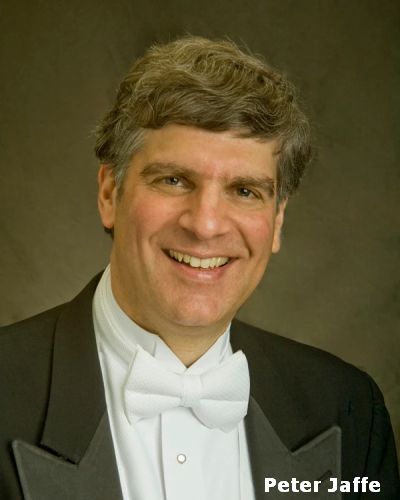 As
I listened to the music that followed, I tried to identify the motifs,
but I wished that I had re-read or seen Romeo and Juliet
recently. I won’t share all my imaginings, but the street arguments
between the Capulets and Montagues seemed clear, as did the sword
fighting and the deaths of Mercutio and Tybalt. And of course there was
the love theme that has been used so frequently in movies, TV shows,
commercials, etc. that it is firmly ensconced in our popular culture.
Actually, familiar as this theme is, I (and I bet the rest of the
audience) found great pleasure in experiencing it in its original form
― with all the variations with which
Tchaikovsky returned to it in his score. What I could recall of
Shakespeare’s play made the drama of the music more immediate and
intense for me, with the constant contrast of violence and love. And
with the deaths at the end of the story, I felt the sorrow in the music.
As
I listened to the music that followed, I tried to identify the motifs,
but I wished that I had re-read or seen Romeo and Juliet
recently. I won’t share all my imaginings, but the street arguments
between the Capulets and Montagues seemed clear, as did the sword
fighting and the deaths of Mercutio and Tybalt. And of course there was
the love theme that has been used so frequently in movies, TV shows,
commercials, etc. that it is firmly ensconced in our popular culture.
Actually, familiar as this theme is, I (and I bet the rest of the
audience) found great pleasure in experiencing it in its original form
― with all the variations with which
Tchaikovsky returned to it in his score. What I could recall of
Shakespeare’s play made the drama of the music more immediate and
intense for me, with the constant contrast of violence and love. And
with the deaths at the end of the story, I felt the sorrow in the music.
Through it all, Jaffe was a protagonist, essentially playing all the parts as he directed the players. With the piece concluded, he turned to the audience with a triumphant smile, his “acting” completed. Amid the applause he left the stage, but the orchestra brought him back for a curtain call with the stomping of their feet, while many in the audience rose to express their appreciation. My seatmate commented to a friend that “you really get drawn in to the drama of the music.” He made this point about the live music compared to a recording or a broadcast. And that’s why people will continue to pay to hear live music. There’s no match for a live performance ― especially from a fine symphony orchestra.
Amit Peled is an Israeli-American cellist who adds conducting and teaching to his international reputation as a top performer. His impressive profile in the attached program underscores how significant was his appearance as a guest performer with the Auburn Symphony. That profile identifies him as “a musician of profound artistry and charismatic stage presence,” and Saturday night’s audience were eyewitnesses to the truth of those claims.
After the intermission, Peled entered the stage from the back and took his seat on a raised square platform to the left of the conductor’s podium. Jaffe followed, and both men were greeted with warm applause. Then, without comment, Jaffe began conducting Dvořák’s Cello Concerto in B minor. I watched Peled’s intense concentration on the orchestra’s opening measures before he himself began to play. Then from the moment he began, I found it fascinating to observe his technique. His fingering was absolutely furious, with speed and precision that seemed beyond human. And he used fingering technique at the base of the fingerboard that I don’t recall having seen used before.
Of course, Peled performed from memory, and with eyes closed, he
seemed to be in another world. Meanwhile, he was bringing remarkable
sounds out of his instrument: usually it seemed to sing, though often it
cried, and occasionally scolded. It struck me what a soulful instrument
the cello is, and as Peled played, I began to appreciate the
complexities of which it is capable ―
in the hands of a master.
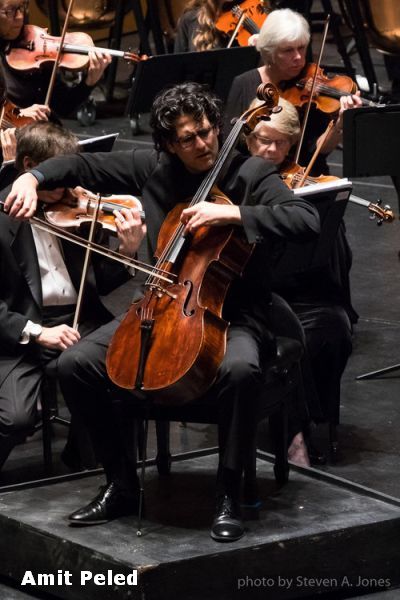 There
was no question that Peled was speaking and feeling through his
instrument. But what he was conveying to the audience did not come
solely from the cello. The intensity of his facial expression, head
movements, and other gestures reinforced the message of his music. I
dare say they were integral to the sounds he was able to produce. And
that inner force that impelled his technique and inspired his passion
did not end when his bow left the strings. At the end of a solo passage,
his arm with the bow would typically fly off in a graceful gesture of
completion. And for all that he seemed in control of his playing, it
occurred to me that in a sense he was possessed by it, and there were
moments when he seemed drained, not just by the physical exertion but by
the emotional journey, as well.
There
was no question that Peled was speaking and feeling through his
instrument. But what he was conveying to the audience did not come
solely from the cello. The intensity of his facial expression, head
movements, and other gestures reinforced the message of his music. I
dare say they were integral to the sounds he was able to produce. And
that inner force that impelled his technique and inspired his passion
did not end when his bow left the strings. At the end of a solo passage,
his arm with the bow would typically fly off in a graceful gesture of
completion. And for all that he seemed in control of his playing, it
occurred to me that in a sense he was possessed by it, and there were
moments when he seemed drained, not just by the physical exertion but by
the emotional journey, as well.
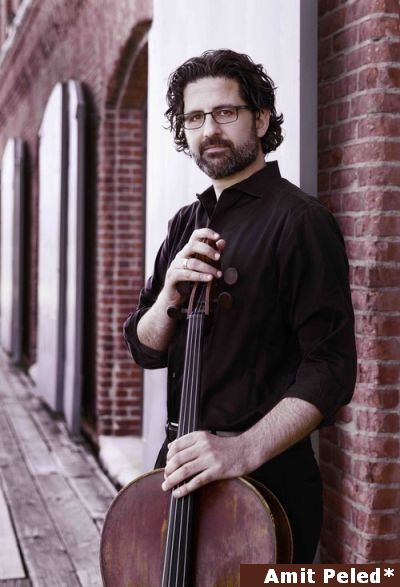 The
Concerto is in three movements, but I think that we in the audience were
completely oblivious to the fact because we erupted in strong applause
at the end of the first movement. I think we could be excused because
this was the “allegro” movement, and we had been completely energized by
the nearly frantic playing of both orchestra and solo cello. Peled
seemed not to mind our applause, and I think Jaffe may have been in part
responsible because I think I recall him relaxing and turning to Peled
at the close of the movement. Noticeably, Jaffe didn’t turn away from
facing the orchestra at the end of the second (“adagio ma non troppo”)
movement.
The
Concerto is in three movements, but I think that we in the audience were
completely oblivious to the fact because we erupted in strong applause
at the end of the first movement. I think we could be excused because
this was the “allegro” movement, and we had been completely energized by
the nearly frantic playing of both orchestra and solo cello. Peled
seemed not to mind our applause, and I think Jaffe may have been in part
responsible because I think I recall him relaxing and turning to Peled
at the close of the movement. Noticeably, Jaffe didn’t turn away from
facing the orchestra at the end of the second (“adagio ma non troppo”)
movement.
The third “allegro moderato” movement was a return to the intense playing. Like the previous movement, it was a cornucopia of musical “ideas.” Although I had read Jane Vial Jaffe’s insightful notes on the piece, I didn’t try to identify, analyze or relate these ideas. Instead, I allowed them to wash over me and take me wherever they led. Like nearly every other major classical work, it was an emotional journey. To me, it represented the highs and lows of human life ― perhaps a richer life than most of us experience, and concentrated into less than an hour.
Having led us on this journey ― which had to have been exhausting for both men ― Peled and Jaffe exchanged a hug of mutual appreciation, while the audience showed their appreciation with a standing ovation, punctuated by whistles. With the orchestra again stomping their feet, Peled and Jaffe took a well-deserved curtain call, and it was some time before the audience’s applause trailed off.
I am often surprised to learn how many people are unaware that Auburn has a symphony orchestra. Its history goes back 30 years, and there’s a video tracing that history at this link. The City of Auburn has an ad in the concert program that makes a significant point: “The City of Auburn would like to thank the Auburn Symphony for their commitment to ensuring that all members of our community have access to world class performing arts. The Auburn Symphony is not only cause for great pride, but an asset that contributes significantly to Auburn’s rich, robust, and diverse cultural ecosystem.” Hear, hear.
Note: As the picture at the top illustrates, Amit Peled performed with the Auburn Symphony in 2018, and you can find a video of the their performance of Shostakovich’s Cello Concerto No. 1 at this link. You can watch and get a sense of the charisma and technical excellence that I observed.
Peter Jaffe photos by Steve Pereira; Amit Peled* photo by Lisa-Marie Mazzucco
Dick Frantzreb is editor of the Capital Region Performance Gallery. He also edits the Sacramento Choral Calendar and the Placer Performance Calendar, and he was a co-founder and past President of the Sacramento Valley Choral Coalition. He has been loving live performances in the greater Sacramento area and writing about them since 2012.
